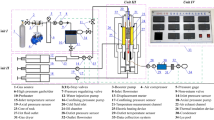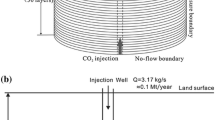Abstract
Though geologic carbon storage (GCS) is widely recognized as a promising strategy to reduce emissions of greenhouse gas (GHG), the potential for mobilization of radioactive uranium (U) from U-bearing minerals in deep subsurface due to CO2 injection remains a concern. In this study, supercritical CO2 and brine flowing through a fracture surrounded by reservoir rock containing uranium is simulated so as to study the potential of uranium release as a result of CO2 injection and the impact of various factors on total uranium release rate. Mineral compositions of the reservoir rock are from previously published literature, which mimics typical sandstone mineral compositions. The reservoir rock is assumed to have 2 × 10−4 vol% UO2 in solid phase. Simulation results show that CO2 injection induces UO2 dissolution, and both CO2 and mobilized uranium are able to migrate in both the fracture and the rock matrix surrounding the fracture. However, the released uranium concentration is quite low in a 60-day simulation period. Mineral dissolution causes a very small porosity increase surrounding the fracture in the simulation period. Sensitivity analysis shows that an increase of UO2 specific surface area and UO2 content in reservoir rock causes a significant increase in released uranium concentration. In other words, total uranium release rate is positively correlated with the specific surface area of UO2 and UO2 content in reservoir rock because the increase of specific surface area and UO2 content increases the total area of UO2 in contact with HCO3− and O2, which raises total uranium release rate. In summary, uranium release in and surrounding the fracture is mainly controlled by uranium supply of the reservoir rock, and the risk of environmental contamination by CO2-induced uranium release is quite low in the scenario reported.
Similar content being viewed by others
References
US-DOE-NETL. Carbon Storage Atlas (fifth edition). U.S. Department of Energy-National Energy Technology Laboratory-Office of Fossil Energy; 2015
White, C.M., Strazisar, B.R., Granite, E.J., Hoffman, J.S., Pennline, H.W.: Separation and capture of CO2 from large stationary sources and sequestration in geological formations—coalbeds and deep saline aquifers. J. Air Waste Manage. Assoc. 53, 645–715 (2003)
Zhang, L., Dzombak, D.A., Nakles, D.V., Hawthorne, S.B., Miller, D.J., Kutchko, B., Strazisar, B.R.: Effect of exposure environment on the interactions between acid gas (H2S and CO2) and pozzolan-amended wellbore cement under acid gas co-sequestration conditions. Int. J. Greenhouse Gas Control. 27, 309–318 (2014)
IPCC (Intergovernmental Panel on Climate Change), 2014. Climate Change 2014: Synthesis Report. Contribution of Working Groups I, II and III to the Fifth Assessment Report of the Intergovernmental Panel on Climate Change [Core Writing Team, R.K. Pachauri and L.A. Meyer (eds.)]. IPCC, Geneva, Switzerland, 151
Benson, S.M., Cole, D.R.: CO2 sequestration in deep sedimentary formations. Elements. 4, 325–331 (2008)
Metz, B., Davidson, O., De Coninck, H., Loos, M. and Meyer, L., 2005. IPCC Special Report on Carbon Dioxide Capture and Storage. Intergovernmental Panel on Climate Change, Geneva (Switzerland). Working Group III
Harvey, O.R., Qafoku, N.P., Cantrell, K.J., Lee, G., Amonette, J.E., Brown, C.F.: Geochemical implications of gas leakage associated with geologic CO2 storage—a qualitative review. Environ. Sci. Technol. 47, 23–36 (2013)
Zheng, L., Apps, J.A., Zhang, Y., Xu, T., Birkholzer, J.T.: On mobilization of lead and arsenic in groundwater in response to CO2 leakage from deep geological storage. Chem. Geol. 268(3), 281–297 (2009)
Kharaka, Y.K., Thordsen, J.J., Kakouros, E., Ambats, G., Herkelrath, W.N., Beers, S.R., Birkholzer, J.T., Apps, J.A., Spycher, N.F., Zheng, L., Trautz, R.C., Rauch, H.W., Gullickson, K.S.: Changes in the chemistry of shallow groundwater related to the 2008 injection of CO2 at the ZERT field site, Bozeman. Montana. Environ. Earth Sci. 60, 273–284 (2010)
Viswanathan, H., Dai, Z., Lopano, C., Keating, E., Hakala, J.A., Scheckel, K.G., Zheng, L., Guthrie, G.D., Pawar, R.: Developing a robust geochemical and reactive transport model to evaluate possible sources of arsenic at the CO2 sequestration natural analog site in Chimayo, New Mexico. Int. J. Greenhouse. Gas. Control. 10, 199–214 (2012)
Trautz, R.C., Pugh, J.D., Varadharajan, C., Zheng, L., Bianchi, M., Nico, P.S., Spycher, N.F., Newell, D.L., Esposito, R.A., Wu, Y., Dafflon, B., Hubbard, S.S., Birkholzer, J.T.: Effect of dissolved CO2 on a shallow groundwater system: a controlled release field experiment. Environ. Sci. Technol. 47(1), 298–305 (2013)
Keating, E.H., Hakala, J.A., Viswanathan, H., Carey, J.W., Pawar, R., Guthrie, G.D., Fessenden-Rahn, J.: CO2 leakage impacts on shallow groundwater: field-scale reactive-transport simulations informed by observations at a natural analog site. Appl. Geochem. 30, 136–147 (2013)
Zhang, L., Parthasarathy, H., Karamalidis, A.: Investigation on arsenopyrite dissolution and As (III) migration under geologic carbon storage conditions: a numerical simulation approach. Greenh. Gas Sci. Technol. 7(3), 460–473 (2017)
Zhang, L., Miao, X., Wang, Y., Lei, H., Li, X. Numerical simulation of subsurface uranium (U) leaching and migration under geologic carbon storage conditions. In: Zhan L., Chen Y., Bouazza A. (eds) Proceedings of the 8th International Congress on Environmental Geotechnics Volume 3. ICEG 2018. Environmental Science and Engineering. Springer, Singapore, 2019
Xu, T., Apps, J.A., Pruess, K.: Mineral sequestration of carbon dioxide in a sandstone–shale system. Chem. Geol. 217(3), 295–318 (2005)
Kiryukhin, A.V., Kaymin, E.P., Zakharova, E.V.: Using TOUGHREACT to model laboratory tests on the interaction of NaNO3-NaOH fluids with sandstone rock at a deep radionuclide repository site. Nucl. Technol. 164, 196–206 (2007)
Zhang, S., DePaolo, D.J., Zheng, L., Mayer, B.: Reactive transport modeling of stable carbon isotope fractionation in a multi-phase multi-component system during carbon sequestration. Energy Procedia. 63, 3821–3832 (2014)
Steefel, C.I., Appelo, C.A.J., Arora, B., Jacques, D., Kalbacher, T., Kolditz, O., Lagneau, V., Lichtner, P.C., Mayer, K.U., Meeussen, J.C.L., Molins, S.: Reactive transport codes for subsurface environmental simulation. Comput. Geosci. 19(3), 445–478 (2015)
Moridis, G., Pruess, K.: TOUGH Simulations of Updegraff’s Set of Fluid and Heat Flow Problems. Lawrence Berkeley National Laboratory Report LBL-32611, Berkeley (1992)
Yamamoto, H.: PetraSim: a graphical user interface for the TOUGH2 family of multiphase flow and transport codes. Groundwater. 46(4), 525–528 (2008). https://doi.org/10.1111/j.1745-6584.2008.00462.x
Pruess, K., Oldenburg, C., Moridis, G.: TOUGH2 User’s Guide, Version 2. Berkeley, CA, Earth Sciences Division, Lawrence Berkeley National Laboratory (2012)
Zhang, L.W., Dilmore, R., Namhata, A., Bromhal, G.: Feasibility of CO2 migration detection using pressure and CO2 saturation monitoring above an imperfect primary seal of a geologic CO2 storage formation: a numerical investigation. Comput. Geosci. 22(3), 909–923 (2018)
Gregory, R.W.: Uranium: geology and applications. Wyoming State Geol. Surv. Public Inf. Circ. 46, 26 (2016)
Zhang, L.W., Soong, Y., Dilmore, R.M.: Numerical investigation of Lower Tuscaloosa sandstone and Selma chalk caprock under geological CO2 sequestration conditions: mineral precipitation and permeability evolution. Greenh. Gas. Sci. Technol. 7(6), 988–1007 (2017)
Zhang, L., Soong, Y., Dilmore, R., Lopano, C.: Numerical simulation of porosity and permeability evolution of Mount Simon sandstone under geological carbon sequestration conditions. Chem. Geol. 403, 1–12 (2015)
Casas, I., Pablo, J.D., Gimenez, J., Torrero, M.E., Bruno, J., Cera, E., Finch, R.J., Ewing, R.C.: The role of pe, pH, and carbonate on the solubility of UO2 and uraninite under nominally reducing conditions. Geochim. Cosmochim. Acta. 62, 2223–2231 (1998)
Eliwa, A.A.: Kinetics and thermodynamics of carbonate dissolution process of uranium from Abu-Zeniema wet crude uranium concentrates. J. Radioanal. Nucl. Chem. 312, 1–11 (2017)
Dunn G, Vagenas J, Teo Y. Uranium Recovery by Continuous Ion Exchange of Alkaline Leachate. Orway Mineral Consultants (WA) Pty Ltd, Western Australia. (2010). Available at orway.com.au. Accessed 5 Feb 2020
Wang, X., Shi, Z., Kinniburgh, D.G., Zhao, L., Ni, S., Wang, R., Hou, Y., Cheng, K., Zhu, B.: Effect of thermodynamic database selection on the estimated aqueous uranium speciation. J. Geochem. Explor. 204, 33–42 (2019)
Gładysz-Płaska, A., Grabias, E., Majdan, M.: Simultaneous adsorption of uranium(VI) and phosphate on red clay. Prog. Nucl. Energy. 104, 150–159 (2017)
EPA (United States Environmental Protection Agency), 2019. National primary drinking water regulations. Available at: https://www.epa.gov/ground-water-and-drinking-water/national-primary-drinking-water-regulations. Accessed 7 Feb 2020
Funding
The authors would like to acknowledge the funding support from the Thousand Talent Program for Outstanding Young Scientists (Y731101B01), the National Natural Science Foundation of China projects (41807275, 41902258, and U1967208), CAS-ITRI collaborative research funding (CAS-ITRI2019011), and the China Postdoctoral Science Foundation project (2018M632948).
Author information
Authors and Affiliations
Corresponding author
Additional information
Publisher’s note
Springer Nature remains neutral with regard to jurisdictional claims in published maps and institutional affiliations.
Rights and permissions
About this article
Cite this article
Zhang, L., Miao, X., Wang, B. et al. Uranium release surrounding a single fracture in a uranium-rich reservoir under geologic carbon storage conditions. Comput Geosci 24, 1883–1893 (2020). https://doi.org/10.1007/s10596-020-09974-1
Received:
Accepted:
Published:
Issue Date:
DOI: https://doi.org/10.1007/s10596-020-09974-1




